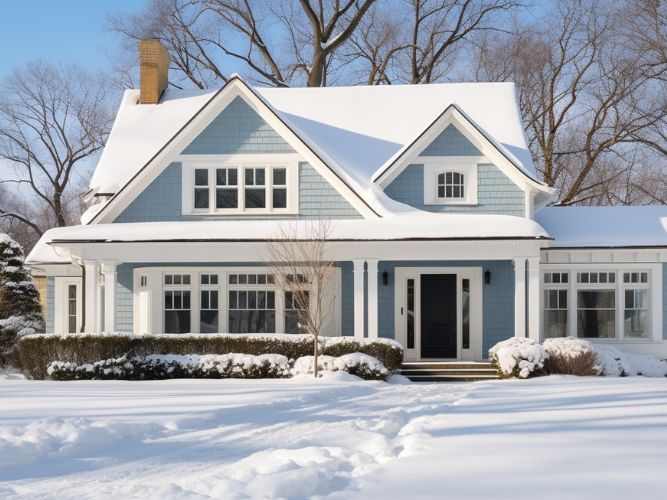Understanding Ice Dams: How to Prevent and Remove Them from Your Roof

TL;DR: Ice dams are a common winter issue causing roof damage and leaks due to uneven roof temperatures and poor insulation. Signs include icicles, ice buildup, leaks, and damaged shingles. They can lead to water damage, structural issues, mold, and higher energy costs. Prevent them by insulating and ventilating your attic, clearing snow, and using heat cables. Remove them safely by creating water channels or hiring professionals. Prevention is key, but if you need help, consider hiring a professional service like Boss Roofing-Siding Experts.
If you’ve ever had to clean ice from your roof, you know how common problem ice dams are during the winter season, especially if you live in a cold region. An ice dam is a thick layer of ice that forms along the edges of your roof, preventing the melting snow from properly reaching the drainpipes and effectively evacuating from the roof.
Ice dams lead to a host of different issues, from less serious ones like water leaks or mold growth to dangerous structural damage. Understanding ice dams is key to understanding how to prevent and remove them from your roof. Today, we’ll focus on what causes them, the dangers they pose, how to remove them easily, and, most importantly, how to prevent them from forming in the future.
Exploring The Root Causes of Ice Dams
Ice dams are primarily a result of nonuniform roof surface temperatures. As heat escapes the house, the snow cover on the roof and outside temperatures interact to eventually form ice dams.
The temperature difference between the roof’s outside surface, which gets above freezing, and the lower surfaces, which remain below freezing, create the ideal conditions for ice dams. As the snow on a roof surface melts, the water flows down the roof, reaching the colder section and freezes, creating the dreaded ice dams.
Another reason why ice dams form is the inadequate insulation and ventilation in your attic. This allows the warm air from your living spaces to rise and eventually escape through the roof. As it gets away, the warm air melts the snow gathered on the rooftop, kickstarting the same process as temperature differences.
Clogged gutters and downspouts can also cause ice dam formation on your roof. Leaves, debris, and ice accumulating in your gutters, if not disposed of properly, get in the way of proper drainage. This, in turn, causes water to back up and freeze along the edges, resulting in ice dams.
Understanding Ice Dams: Reading the Signs of Roof Ice Dams
Early detection of ice dams makes a great difference in preventing further damage to your roof. The signs to be on the lookout for include:
- Icicles: Large icicles hanging from the edges of your roof might look cool, but they directly correlate with the formation of ice dams. They form as the melted snow refreezes along the eaves, indicating the potential presence of dams along the edges.
- Ice buildup: As ice forms and piles up on your gutters and downspouts, you should react as soon as possible since ice dams are likely present on the roof.
- Water leaks: Water seeping through your roof, walls, or ceilings should worry you regardless of season. Witnessing it during the winter should raise immediate concerns as the leaks may be down to ice dams, causing a breach in your roofing system.
- Damaged shingles: Shingles can get damaged or displaced as a result of ice dams, so any changes in the appearance or condition of your roof are worth investigating, particularly during the cold months.
The Dangers and Damages Caused by Ice Dams
If you’ve never had to deal with ice dams, you might be underestimating how dangerous they really are. The damages they can cause might end up wreaking havoc on your entire home if you leave them unaddressed. Let’s look at a few of the most direct ice dam-related dangers you need to be wary of:
- Water leaks: The most immediate problem to address when facing ice dams on your roof is water leakage. Ice dams prevent drainage, so the gathering water can seep into your home through gaps in your roof, leading to ceiling stains.
- Structural damage: A repeated cycle of melting and refreezing might cause significant damage to your roof and all supporting structures. And all structural damage leads to costly repairs.
- Mold growth: As moisture gets trapped by ice dams, it creates the perfect growth environment for mold. The dangers of mold are diverse and serious, not only threatening your home’s structure but also the health of all occupants.
- Increased energy costs: Poor insulation and ventilation, which can contribute to the formation of ice dams, also raise energy bills. Warm air escapes your home constantly, forcing your heating system to work harder to maintain the temperature.
Tips to Prevent Ice Dams From Forming
Before we look at how to remove ice dams or why you need professional services to do it for you, let’s learn the basics of prevention. It is much easier to stop ice dams from forming in the first place, thus avoiding the related potential damages. The following few tips may make a real difference in keeping your roof ice-free during the cold season:
Insulating Your Attic
Somehow, every aspect of roof ice dams comes back to the isolation and ventilation aspects of your home. Adequate insulation helps to keep the warm air inside your living spaces, and you already know why it’s crucial in preventing ice dam formation by balancing the temperature differential.
Ventilating Your Attic
Ventilating the attic is equally important. Proper ventilation allows for the exchange of air, removing excess heat and moisture from your attic. This helps to keep the same temperature throughout your roof, further reducing the risk of ice dams.
Clearing Snow from Your Roof
Since snow is the crucial component that leads to ice threatening the integrity of your roof, not allowing it to gather is another effective preventive measure. A roof rake is extremely helpful in easily removing snow from the edges of your roof and the hot spots where ice dams tend to form.
Using Heat Cables
Also known as heat tapes, roof de-icing cables are very helpful when you install them along the edges of your roof. Their main function is generating heat which melts the accumulated snow and ice, improves drainage and clears the roof.
Safe Ice Dam Removal Methods
When you notice that ice dams have already formed on your roof, act without delay. Removing ice dams requires using the correct tools, but what’s most important is to be aware of the dangers regarding your personal safety. If you’re looking to remove ice dams yourself, here are a few things you can do:
Avoid Using Sharp Tools and Excessive Force
Sharp tools such as ice picks or hammers are not just ineffective in removing ice dams, but they can also cause further damage to your roof. Using excessive force in addition to inadequate tools can lead to injury to yourself or even more damage to the roof.
Create Channels for Water to Escape
Creating channels in the ice dams instead of attempting to remove them by force allows water to flow slowly off your roof, dissolving the channels along the way. Warm water is all you need, with a spray bottle the method of choice for easy application.
Ask for Professional Help
If the ice dams are extensive or you’re not comfortable removing ice dams by yourself, you should consider hiring professionals. They have the required experience, tools, and knowledge to safely and swiftly remove ice dams without causing any damage.
Remove Ice Dams Safely and Effectively with the Help of Boss Roofing-Siding Experts
Ice dams can definitely cause you headaches during the winter months. Understanding ice dams is the first step you must take when trying to figure out how to prevent and remove them from your roof. There are different methods to get rid of rooftop ice dams by yourself, but prevention beats removal, so developing a prevention strategy to deal with ice dams before they start causing damage is your best option.
The easiest way to say goodbye to ice dams and protect your roof, home, and family from the potential dangers and damages they can cause is to employ a professional service like Boss Roofing-Siding Experts. Don’t let ice dams cast a cold shadow on your winter – contact us now to schedule an intervention and enjoy a worry-free cold season.
FAQ
What are the dangers of ignoring ice dams on my roof?
Ignoring ice dams can lead to severe issues such as water leaks, structural damage, mold growth, and increased energy costs. Prompt action is essential to prevent these problems from escalating. At Boss Roofing-Siding Experts, we understand the urgency of addressing ice dams to protect your home.
How can I prevent ice dams from forming in the first place?
Preventing ice dams involves proper insulation and ventilation in your attic, clearing snow from your roof, and using heat cables along the edges. Our team at Boss Roofing-Siding Experts can assess your home’s needs and recommend effective prevention strategies tailored to your specific situation.
What should I do if I notice ice dams on my roof?
If you notice ice dams on your roof, it’s crucial to act quickly to prevent further damage. Avoid using sharp tools and excessive force, as they can cause injury or damage to your roof. Instead, create channels for water to escape slowly or consider seeking professional help. At Boss Roofing-Siding Experts, we offer safe and effective ice dam removal services to protect your property.
Why should I hire professionals like Boss Roofing-Siding Experts for ice dam removal?
Hiring professionals for ice dam removal ensures the task is completed safely and effectively, minimizing the risk of damage to your roof or injury to yourself. Our team has the expertise, tools, and experience to remove ice dams swiftly without causing further harm to your property. Don’t let ice dams ruin your winter – contact Boss Roofing-Siding Experts for reliable and professional assistance.





